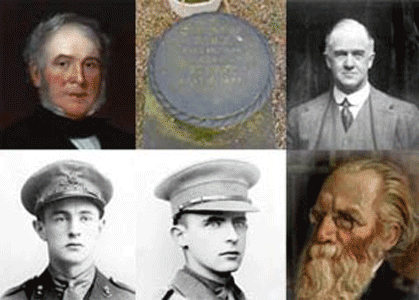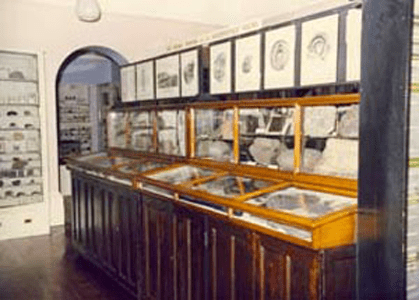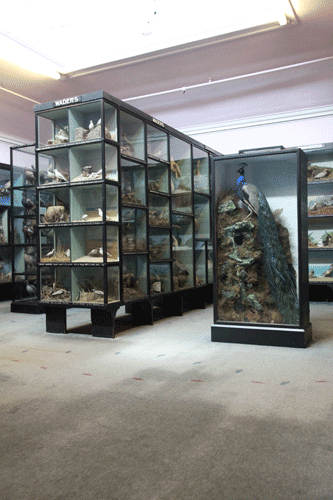The story of Tolson
Discover the history of Ravensknowle Hall and how it became Huddersfield's museum. You can also read the fascinating story of how the museum developed into what we see today.
The hall and the museum
Before 1850 Ravensknowle was farmland on the edges of Dalton in the parish of Kirkheaton; a handful of cottages and homesteads stood along the road, now Ravensknowle Road. The original Ravensknoll was a farmhouse on the south-east side of this road.
In 1832 part of the Ravensknowle estate, including the area of the present public grounds, were bought by a Huddersfield banker, Thomas Wilson. He built a lodge at the Ravensknowle Road entrance, but in 1850 the land was bought by his nephew John Beaumont, a woollen manufacturer. John Beaumont built Ravensknowle Hall (now Tolson Museum) between 1859-62, reputedly at a cost of over £20,000.
The Hall was designed by Richard Tress, a busy but unoriginal London architect, and is a text book piece of work. It shows the plan of a Victorian mansion, with its separate stable block and the spacious interiors of the reception rooms which contrast with the pokiness and severity of the servant's quarters. The visitor can still see much of the room arrangement in the museum.
Until 1919 the estate (apart from a brief period) remained in the same family, passing from uncle to nephew, from father to daughter and from cousin to cousin. However, the casualties and social upheaval caused by the First World War disrupted middle class life. In 1919, Legh Tolson gifted the Hall and part of the grounds to the Huddersfield Corporation, as a memorial to his nephews Robert Huntriss Tolson and James Martin Tolson, both killed during the fighting.
'The Tolson Memorial' became a museum, organised by Dr T W Woodhead of Huddersfield Technical College. It became one of the country's leading local museums, systematically organised according to a progression of subjects. It was an educational institution, using models, casts and removable display units with visiting parties.
- You can watch Loss and Legacy - The Tolson Story film. The film tells the poignant story of the Tolson brothers and the profound effect the First World War had on the family.
- John Beaumont of Dalton, JP - 1808-1889
A successful businessman who had Ravensknowle Hall designed and built, using the profits of his fancy waist coating manufacturing business and successful railway investments. He was also a senior director of the North British Railway Company. Beaumont must have relished the social responsibilities his wealth and position imposed, as he sat on the Huddersfield magistrates bench up to within 6 months of his death from 'natural decay' at the age of 81. He left the sum of £520,000.
- Mrs Sarah Martha Grove Grady
The daughter of John Beaumont, Sarah, married a London barrister and didn't live at Ravensknowle after inheriting it. In 1901 she sold it for £6,000 to her cousin, Legh Tolson. Widowed early, she lived at Ilkley and fashionable south-east coastal towns. In her 1925 will she left around £400,000 for animal wildlife sanctuaries. The will was set aside as invalid, but a sum funded part of the Royal Veterinary College called the Beaumont Hospital for Sick Animals. Other beneficiaries were vegetarians, anti-vivisectionists and the 'London Association for the Prevention of Premature Burial', which was requested to examine her body to prevent the chance of her being buried alive.
- Legh Tolson FSA
The last private owner of Ravensknowle Hall who gifted the building and part of the land to Huddersfield Corporation. In the 1900s Legh Tolson made additions, creating a separate 'dwelling house' - Ravenhill - and rented out both parts. Tolson, an antiquarian and the historian of Kirkheaton, resumed residence during World War 1. In 1919 he presented the hall and part of the grounds to the Huddersfield Corporation for a museum, as a memorial to his two nephews who died in the war. He moved to the Lake District. In 1929, his book 'Kirkheaton' was published privately in a limited edition - copies are now rarities.
- James Martin Tolson
Nephew of Legh Tolson - one of the two brothers the museum is dedicated to - find out more in First World War.
- Robert Huntriss Tolson
Nephew of Legh Tolson - one of the two brothers the museum is dedicated to - find out more in First World War
- Seth Lister Morley
First curator at the museum in 1922. His amazing 'Bird Gallery' can still be seen - find out more in The Birdman: Seth Lister Mosley

- First World War
Legh Tolson owned and lived at Ravensknowle Hall during the First World War. The deaths in the war of the two young sons of his brother, Whiteley, inspired him to present the Hall and part of the grounds to the people of Huddersfield in 1919 as a memorial, for a museum.
- James Martin Tolson
James was 2nd Lieutenant in the 74th Battery, Royal Field Artillery Guards Division. He was born on 26th March 1898. He was wounded in 1917 while in service and gassed in 1918. James was then killed in action in the attack on Solesmes on the 20th October 1918 and is buried at Quievy, France.
- Robert Huntriss Tolson
Robert was 2nd Lieutenant in the 15th Battalion, West Yorkshire Regiment. He was born on 6th November 1884 and saw active service in Egypt. He was killed in action at the first battle of the Somme on 1st July 1916. He is buried at Serre Road Cemetery, Near Hebuterne in France.
Dr Woodhead's 'Scheme for the Development of a Local Museum' began with the principle that a museum should be an educational institution and illustrate the main factors at work in man's environment. It should be a local museum because 'local factors... are the same as general or universal factors, and the fundamental lessons concerning them can be learnt most effectively by a study of local conditions'. He set out why a provincial museum should avoid accumulating objects from outside the locality.
Opened in 1922, the museum's original collections came from three main sources. The first was a museum developed by Dr Woodhead at Huddersfield Technical College. The second was Roman material excavated from Slack from the University of Leeds. The third was a private museum of ornithology belonging to Seth L Mosley. Seth Mosley became the first Curator under Dr Woodhead as Director.
At the request of Legh Tolson who was still living in the hall in 1920, the first materials were carted up by the back entrance. Few structural alterations were made to the building and the original arrangement of subjects in the rooms were kept many years. The Director also supervised the Park and as well as being an amenity with tennis courts, bowling green and aviary, it was a location for work on ornithology, the growth of plants and a meteorological station. Historical items too large for the museum were put in the park, the most striking being the east entrance to the old Cloth Hall.
In the 1920s and 1930s, important local collections of natural history, archaeology, 'bygones' and local photographs were acquired. The first extension to displays was the Bird Room in 1925. In 1936, the opening of the Woodhead Memorial Hall gave the museum a proper lecture hall.
The Curators and Directors of the museum had all been specialists in science or natural history but their interests were not limited. Through research work and publications, the museum made strong contributions to local history and archaeology in addition to scientific subjects. Under the Director Mr E W Aubrook, FMA, an outstanding collection of toys, dolls and children's playthings was built up.

Seth L Mosley was the first curator of Tolson Museum and created the remarkable 'Bird Room'.
His grandfather and father were both taxidermists. Seth, a sickly child, disliked school, admitting he was an "untrained, non-schooled, working man". While very young Seth was taken in search of birds and butterflies; he scratched shapes of birds in the sand on the cottage floor before he could walk. He painted birds and butterflies to sell to his father's visitors and began taxidermy and his bird collection. Given a small gun by his father, he soon abandoned it, condemning "wholesale slaughter" urging that the "wanton destruction of life - should be rigidly discouraged".
Poor in health, Seth did not work as early as most boys, but at 15 was apprenticed to a firm of painters. He spent his free time drawing, painting and collecting birds and insects. In 1869 he married Sarah Taylor and had a family, living at Beaumont Park for 35 years, with a specific room to display collections for visitors.
Seth was a prolific writer and artist, active in societies and wrote for journals. His best known works, illustrated by hand, were 'Butterflies of Europe', 'British Birds, Nests and Eggs', and 'Birds of Huddersfield'. In 1904 he built a new house, but had so many visitors that a larger building was erected. He was his own architect, designing areas for displaying his collections.
He later moved his collections to Huddersfield Technical College, where he was teacher and Curator. In 1920 he became first curator of Tolson Museum, creating the early displays, most notably his 'Bird Room'. Mosley is remembered as a "friendly, stocky man, dressed more like a tramp", rambling through countryside, "investigating nature". In three public parks he labelled trees, managed botanic gardens and fitted nest boxes. He also completed a survey of the Upper Aire Valley.
Seth's last article in the Huddersfield Examiner summarises his view of nature: "Nature has one object in view - perfection. Every year, every day, she gets nearer to her destination and the time will come when men will see the wisdom of Nature and adopt her plans and follow her path; not till then shall we have 'Peace on earth and good will towards men'."

In 1974, Huddersfield was joined with Dewsbury and Batley to become the Metropolitan Borough of Kirklees. Tolson Museum became part of a much larger service which included museums at Dewsbury and Batley, historic houses of Oakwell Hall and Red House, and Huddersfield Art Gallery.
Although the collections at the museum continued to grow, there was little money to update displays until the 1980s. From 1981 Kirklees invested much time and money (aided by grants from government agencies) in a refurbishment of the building and renewal of the galleries. All displays were completely renewed to modern standards, except the Bird Gallery, added by Seth Mosley in 1925 and preserved as a still-interesting and informative example of pre-war museum design.
The new displays told the story of the museum and its collections and also the history of the people in the Huddersfield area from prehistoric times to the present day.
The museum continues to develop, and welcomes tens of thousands of visitors each year. It offers a lively programme of special exhibitions, events, workshops, family activities, educational visits and an enquiry service.
| Date | Events |
|---|---|
| Middle Ages | Ravensknowle lands subject to a rental paid to the Commandery of the Templars at Newland, near Normanton. |
| 1466 | Earliest mention "William Dygton of Rawensknolle" witnesses a document. |
| 1481 | Land probably sold to Thomas Savyle (Savile). |
| 1496 | Land owned by Richard Wheatley (and descendants). |
| 1617 | Owned by Tomas Wheatley. |
| 1660 | Ravensknowle passed to the Wilkinson family. |
| c.1725 | Wilkinson's heiress married Sir John Lister Kaye, taking land as part of her inheritance. |
| 1827 | Estate divided and sold by Sir John's trustees. Land to the north bought by Thomas Wilson, banker. |
| Pre 1850 | Thomas Wilson built cottage on Ravensknowle Road as a lodge for a new house he intended to build but never did. |
| 1850 | Thomas Wilson sold estate to his nephew, John Beaumont, cloth manufacturer. |
| 1859-62 | Ravensknowle Hall built by John Beaumont. Architect: Richard Tress of London. |
| 1889 | Death of John Beaumont. House left to his daughter Mrs Sarah Martha Grove Grady. |
| 1900 | House leased to Robert Holliday (Huddersfield firm of colour chemical manufacturers). He died 1901. |
| 1901 | House sold to Legh Tolson, cotton manufacturer for £6,000. |
| 1902 | House altered and extended to make two separate houses: Ravensknowle and Ravenshill. |
| To 1914 | Tenants: • Ravensknowle - C F Sykes • Ravenshill - G T Rhodes (to 1912) |
| World War 1 | Legh Tolson in residence. |
| 1919 | House and grounds presented as a museum in memory of Tolson's nephews killed in the war. |
| 1922 | Opened as a museum. |
| 1925 | Bird Room opened. |
| 1935 | Lecture Room added. |
| 1974 | Rear extension added. |
Was this information useful?
We'd like your feedback to improve the Kirklees Council website and the information we provide.




